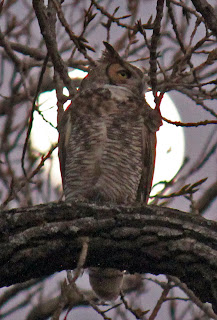Eagles in Dallas County’s Trinity River Basin
 |
| The twilight evening moon setting behind an Osprey (fish eagle) in the floodplains of Dallas, Texas January 2013 |
The modest world of topographical study does not lend itself well to the open prairie of North Texas. Attempts at flattering comparisons to that of the Texas Trans-Pecos or rolling Hill Country fall flatter than the land itself. Most of what made this land so special to pioneers, why they settled here instead of the rough hewn rolling cedar hills further west is an answer lost to most. The grand prairie grass plains.
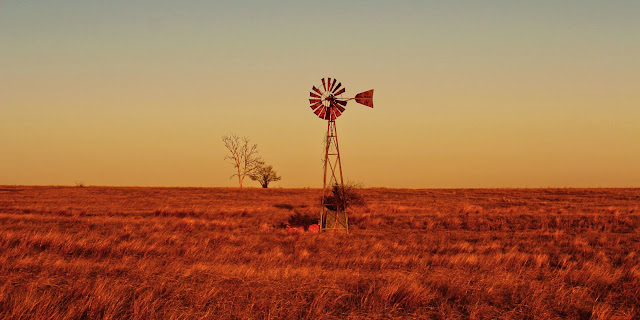 |
| Restored Tall Grass Prairie in Southeast Dallas County near the mouth of Ten Mile Creek and the Trinity River |
There was a time not long ago when settlers to North Texas would send letters back east proclaiming the vast shoulder high grasses that extended as far as the eye could see. The Indian, buffalo, grama, big and little bluestems, names forgotten to most. That epic carpet of grass, has long since been subdivided, housed and paved over. Remnants still exist. Patchwork quilted along old railroad sidings, vacant lots and forgotten farm family cemeteries. You don’t get a feel for it though. The ocean of grass moving like waves on water. The aesthetics of a fast moving red lit sunset moving across a field so fast you cannot keep pace. Here, you can experience that. This panoramic view attracts more than the wandering human eye but also that of winged predators who feast on the rich fields of quarry that these fields invite.
 |
| Ten Mile Creek valley overlooking the South Creek Ranch’s Red Angus herd with Riverbend Preserve in the far treeline beyond. Dallas County Texas. |
In order to see such a sight, one of large tract native grass vistas, one needs to head into the farthest corner of Dallas County. It’s a great place few know exist. It’s not on the way to anywhere. It serves as no shortcut. The roads can become impassable after heavy rains. I offer this area as one of the best to see eagles this winter inside Dallas County.
While the eagles featured in this post were often photographed inside the city limits of Dallas and inside the confines of Loop 12, the more remote areas of Southeast Dallas County afford the best chance to see one. Parkinson and Wolf Springs Roads seem to be the best option if one wishes to keep your sightings a car bound affair. For the more adventure seeking, one of the least visited Dallas County nature preserves sits right in the middle of this eagle rich countryside. A few months ago, Chris Jackson made a detailed report of his trip to the preserve and Lock and Dam #4. He has spotted numerous bald eagles inside the metroplex this winter including some around the south side of the Lewisville Lake Dam.
 This area in Southeast Dallas County is literally a place where the pavement ends. This is one of the only places I know of in Dallas County where you can literally see a mile in any direction and literally sit in the middle of the road if the mood strikes without worry of being run over. The silence is deafening on windless visits here. Beyond lies the unkempt roads of rural Ellis County and roads aptly named after places they once served. Sawmill. Log Ranch. Trinity Basin. Ten Mile.
This area in Southeast Dallas County is literally a place where the pavement ends. This is one of the only places I know of in Dallas County where you can literally see a mile in any direction and literally sit in the middle of the road if the mood strikes without worry of being run over. The silence is deafening on windless visits here. Beyond lies the unkempt roads of rural Ellis County and roads aptly named after places they once served. Sawmill. Log Ranch. Trinity Basin. Ten Mile.
River bottoms such as these are prime real estate in the winter for large birds of prey, the largest seen in Texas are eagles.The Trinity is often overlooked for eagles. The Colorado and Brazos to the south steal the thunder of North Texas when it boils down to the grit.
Why Southeast Dallas County Attracts Eagles
 |
|
| Current Bird’s Eye View of Ten Mile Creek where it enters the Trinity River north of Wolf Springs Road in Dallas County |
 |
| 1900 Map showing Ten Mile prior to channelization |
For millennia a quiet war of wills has raged down here between the land and the river that cuts through it. From the north the river has hauled down tons of silt many times over and deposited them annually on these fields. The near biblical floods of pre-history have changed the course of the river and tributaries here often. The long forgotten riverbeds go by new names, Cottonwood Slough to the west and Parson’s Slough to the east.
 |
| USGS India Quadrangle noting old Ten Mile Creek Streambed |
Man has changed the streams here too. The rich flood prone land impeded farming in the early parts of the last century. Efforts were made around the First World War to reclaim some of this land and put it into production without worry of seasonal flooding.
 |
| 2012 aerial view of Wolf Springs Road with old Ten Mile streambed visible |
This was one of the earliest forays of Dallas County into rechanneling a stream. At top right the Dallas County Map of 1900 shows Ten Mile Creek headed south into Ellis County where it reached the Trinity some distance below the county line. The circa 1917-1920 public works project moved the mouth far to the north well inside Dallas County on an east-west path. A series of small levees were built in this area which contributed to flood protection.
It’s worth noting this century old project because the wildlife still seem to congregate along the old creek channels. This shift of streams greatly plays an integral role in the sheer numbers of animals in the area.
Smaller tributaries such as Bear Creek were also moved as a result of this project and funneled south to join Red Oak Creek near it’s mouth with the Trinity River.
The Crested Caracara –The Sacred Eagle of the Aztec
 |
| Crested Caracara beginning a gliding dive over Ten Mile Creek |
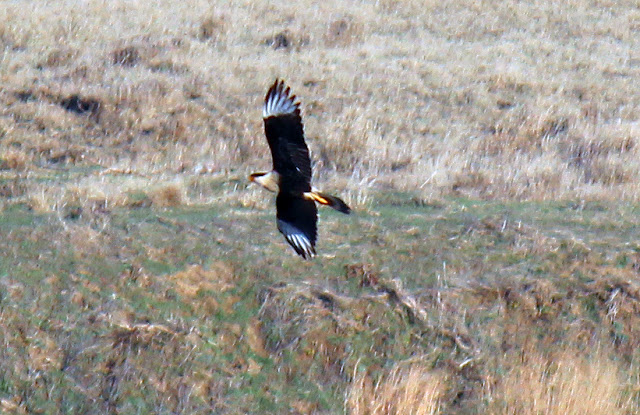 |
| Crested Caracara hunting over Ten Mile Creek near the Trinity River |
 |
| Aztec Warriors as depicted in the Florentine Codex |
Here among the patchworked squares of Ten Mile Creek bottom works one of the most revered and mythic eagles of North America, the Crested Caracara (Caracara cheriway).
The Caracara has long been a sacred bird for the people of Mexico. Steeped in deep legends of the Aztecs of interior Mexico, the sighting of one had deep significance. The symbol of the Caracara is immortalized in the petroglyphs of Aztec pyramids across the region.
The most fearsome of Aztec shock troops the Eagle and Jaguar Warriors wore suits fashioned from the feathers of the Caracara. Called the cuāuhocēlōtl these soldiers were the most disciplined and during the Spanish Conquests of Mexico could fight the well armored Conquistadors on an even field.
 |
| Crested Caracara hunting a field near Ten Mile Creek |
The Caracara is now represented on the national flag of Mexico. Some liberties have been taken with the coloration to reflect the appearance of a Golden Eagle. The story goes that the Aztecs in 1325 AD received a vision or a sign through one of their many gods that told them they would know where to build their central city, the empire of Tenochtitlan when they saw what is today depicted on the Mexican Flag. They were told that when they saw an Eagle perched on a Nopal cactus with a serpent in its talon, located on an island, this is where they should begin to build their permanent city. They supposedly did encounter this on an island in the middle of a lake (Lake Anahuac) now known today as Mexico City.
 |
| Caracara with a snake in beak |
I find this story relevant because the Caracara seen in Dallas County hunting over the sunny but cool fields of Ten Mile Creek came up with a snake as a late afternoon meal. Seen pictured at right. This is most likely one of a mated pair that loiters up and down the river in this area over the last few winters with regular frequency.
These birds have the body and span of an eagle but tend to forage more on a wide array of carrion if the opportunity presents itself. It would be fair to say that the have the body of an eagle and the mind of the most depraved vulture. I have seen Caracara as far north as the old Progreso Farm location on Pemberton Hill Road in 2009-2010. The area was strewn with discarded animal remains at the time from a slaughterhouse operation. As a result the area was thick with carrion loving birds.
 Caracara are actually listed as a Threatened Species under the Endangered Species Act. Much like the Wood Stork that ranges through this Dallas countryside in the summer months, the habitat threatened Caracara is listed not for the ranging birds from Mexico but those residing in Florida. At some point in the past a vast extinction event took place along the Gulf Coast between Florida and Texas separating the populations into two distinct groups. The Endangered Species Act contradicts itself in a few areas regarding species protection. Rather than separate the population into subsets, the species as a whole is protected.
Caracara are actually listed as a Threatened Species under the Endangered Species Act. Much like the Wood Stork that ranges through this Dallas countryside in the summer months, the habitat threatened Caracara is listed not for the ranging birds from Mexico but those residing in Florida. At some point in the past a vast extinction event took place along the Gulf Coast between Florida and Texas separating the populations into two distinct groups. The Endangered Species Act contradicts itself in a few areas regarding species protection. Rather than separate the population into subsets, the species as a whole is protected.
Caracara are a somewhat rare sight in Dallas County. They are most often seen around landfills in Irving, Dallas, Mansfield. North of the DFW metro area they are very seldom seen. Maybe in coming years as this species population improves more will be seen towards the Red River.
The Bald Eagle — The Trinity River Duck Hunters
 |
| Ducks in flight over the Trinity River Wetland Cells |
In a woodsy corner of Pleasant Grove the ducks stack up in mid-winter thicker than a traffic jam on Central. Safety in numbers from feathered foes loitering above waiting to pounce for an easy breakfast.
 |
| Juvenile Bald Eagle (Haliaeetus leucocephalus) in the Great Trinity Forest near the confluence of White Rock Creek and the Trinity River, Pemberton Hill, Dallas Texas, January 19, 2013 |
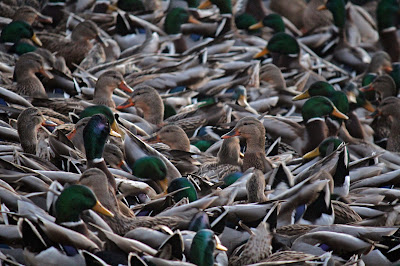 I chalk up the drought of 2011 for a less than productive year of eagle sightings in the Great Trinity Forest. The scant food and dried pocket ponds caused many of the wintering waterfowl to head further south to the coast. With the ducks went many of the eagles who follow like lions stalking a wildebeest migration.
I chalk up the drought of 2011 for a less than productive year of eagle sightings in the Great Trinity Forest. The scant food and dried pocket ponds caused many of the wintering waterfowl to head further south to the coast. With the ducks went many of the eagles who follow like lions stalking a wildebeest migration.
Bald Eagles are rather punctual as a breed. Give or take a week they always seem to show up about when expected. It was disappointing not to see them last winter. The ebb and flow of winged wildlife is only tied to food sources and weather. Both in short supply last winter. A near normal spring and summer yielded more food and shelter this winter holding the ducks here in Dallas for a longer period.
 |
| Adult Bald Eagle (Haliaeetus leucocephalus) near the mouth of Ten Mile Creek and the Trinity River, Riverbend Preserve, Dallas County Texas, January 13, 2013 |
Inside the city limits of Dallas eagles are seen much less frequently. Casual documented observations have been made at White Rock Lake in years past but they are very infrequent and the birds seldom stay long. The photos above show two common adaptations of Bald Eagles. The juvenile Bald Eagle was seen in the Pemberton Hill area on January 19, 2013. As is customary these oddball sightings always seem to involve Bill Holston a Master Naturalist and all around master hiker to boot. I being armed with a camera and he armed with binoculars, we both scratched our heads about the odd looking juvenile bird. It was not until a look through the images post hike I was able to see it was a Bald Eagle. It might have fooled us humans but the ducks pecking away at morning breakfast in the pond ahead of us knew what it was………..
 |
| Ducks in a flooded Pleasant Grove field near the Trinity River, scattering at the sight of a juvenile Bald Eagle |
….like a Chinese fire drill.
It can take years for a Bald Eagle to develop the hallmark white head. Seen in a photo above, that particular adult Bald Eagle was seen down near Ten Mile Creek, a healthy distance away over a grove of large trees. The great majority of the Bald Eagles in this area are merely transients and are not building nests in the Dallas area. The Great Trinity Forest has a very few scant trees that would even be capable of Bald Eagle nest habitat. The eagles seen in Dallas proper most likely commute from larger bodies of water like Ray Hubbard, Tawakoni and Richland Chambers where eagles reside in greater numbers during the winter.
 |
| Great Horned Owl |
The Great Trinity Forest and White Rock Creek drainage does make for excellent owl habitat. Wearing a coat of natural bark camouflage Barred Owls and Great Horned Owls are a worthwhile pursuit within a half hour of sundown in the woods here. No special equipment is needed. Just a sharp set of eyes and the patience to find them.
 |
| Barred Owl near the Buckeye Grove |
Osprey — Fish Eagle of the floodplain
 |
| Osprey (Fish Eagle) feasting of a freshly caught carp in Dallas Texas under a rising moon |
 |
| Fog rising among White Rock Creek’s five story tall trees in the Great Trinity Forest, Rochester Park |
The Osprey and owls are the only raptors whose outer toe is reversible, allowing them to grasp their prey with two toes in front and two behind. Known as fish eagles, sea hawks and fish hawks the Osprey(Pandion haliaetus) is one of the great winged aquatic hunters of North America. The special talons allow the osprey to firmly hold onto slippery fish which makes up the primary source of food in the diet.
This particular species of bird is often seen diving head first towards water then using razor sharp talons to deliver a devastating blow.
Widespread across the globe, these birds live on every continent but Antarctica.
 |
| Osprey clutching a carp on a cottonwood tree |
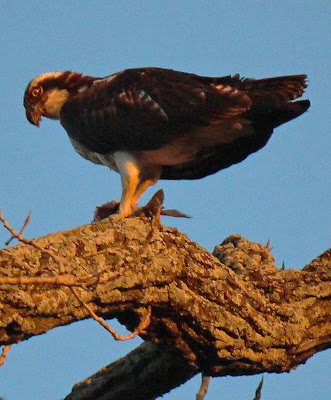 Suffering a similar fate of the Bald Eagle, the widespread use of the pesticide DDT had negative impacts on the Osprey population in the last century. Due to the widespread geography of the Osprey the overall health of the species was maintained during the use of that chemical. The numbers are now up higher than before and the Osprey is becoming a more familiar sight far into the plains of Texas.
Suffering a similar fate of the Bald Eagle, the widespread use of the pesticide DDT had negative impacts on the Osprey population in the last century. Due to the widespread geography of the Osprey the overall health of the species was maintained during the use of that chemical. The numbers are now up higher than before and the Osprey is becoming a more familiar sight far into the plains of Texas.
The Osprey in these photographs is an infrequent visitor along the White Rock Creek drainage. Being a unique bird to the area it’s unknown whether or not similar sightings this past fall of an Osprey near the mouth of White Rock Creek are the same bird.
Much of the wildlife habitat in this thread exists not through preservation of habitat but rather private conservation efforts by places like the South Creek Ranch. Proper rural land stewardship and not overworking the land has provided not only for excellent grazing and agriculture. It has dramatically increased the diversity of species that were for all practical purposes once hunted or driven to extinction inside Dallas County.
It seems that without reservation that the Trinity River Project faces problems far greater than most people realize. The mismanagement of this resource across a broad scale is starting to impact the natural wildlife that is just starting to make a toe hold back into the woods. No amount of money can create some of the sights down there. But for a price, you can destroy it.


